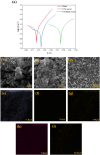Enhanced long-term corrosion resistance and self-healing of epoxy coating with HQ-Zn-PA nanocomposite
- PMID: 40059093
- PMCID: PMC11891328
- DOI: 10.1038/s41598-025-92158-7
Enhanced long-term corrosion resistance and self-healing of epoxy coating with HQ-Zn-PA nanocomposite
Abstract
This study developed a self-healing, anti-corrosive coating based on a novel nanocomposite formulation of 8-hydroxyquinoline-5-sulfonic acid-zinc doped polyaniline (HQZn-PA) incorporated into an epoxy matrix. The chemical composition and surface morphology of the synthesized nanocomposite were thoroughly characterized using Fourier transform infrared spectroscopy, X-ray diffraction, nuclear magnetic resonance, and scanning electron microscopy. Electrochemical impedance spectroscopy and potentiodynamic polarization tests confirmed the outstanding corrosion resistance and self-healing efficiency of the coating. The synthesized HQZn-PA demonstrates enhanced anticorrosive properties through the synergistic effects of its constituents. Polyaniline (PA) contributes anodic protection and forms a barrier layer, while the chelation of zinc by 8-hydroxyquinoline-5-sulfonic acid (HQZn) improves PA compatibility within the polymer matrix and functions as an organic corrosion inhibitor. This dual action strengthens corrosion resistance through both anodic and cathodic protection mechanisms. The HQZn-PA nanocomposite reduced the corrosion rate of epoxy coating by 450× compared and maintained an impedance modulus of 1.03 × 1010 Ω cm2 after 40 days in a saline environment. The nanocomposite also demonstrated a self-healing efficiency of 99.28% in scratched coatings. These results highlight the potential of HQZn-PA as a highly effective corrosion inhibitor and self-healing agent for long-term metal protection in harsh environments.
Keywords: 8-Hydroxyquinoline-5-sulfonic acid; Anti-corrosion; Nanocomposite coating; Polyaniline; Self-healing.
© 2025. The Author(s).
Conflict of interest statement
Declarations. Competing interests: The authors declare no competing interests.
Figures











Similar articles
-
Anti-corrosion and self-healing coatings with polyaniline/epoxy copolymer-urea-formaldehyde microcapsules for rusty steel sheets.J Colloid Interface Sci. 2022 Jun 15;616:605-617. doi: 10.1016/j.jcis.2022.02.088. Epub 2022 Feb 22. J Colloid Interface Sci. 2022. PMID: 35231704
-
Amino-Functionalized MXene Nanosheets Doped with Ce(III) as Potent Nanocontainers toward Self-Healing Epoxy Nanocomposite Coating for Corrosion Protection of Mild Steel.ACS Appl Mater Interfaces. 2021 Sep 8;13(35):42074-42093. doi: 10.1021/acsami.1c13055. Epub 2021 Aug 25. ACS Appl Mater Interfaces. 2021. PMID: 34428889
-
Corrosion Protection Properties and Mechanism of Epoxy/Acetic Acid-Doped Polyaniline Coating on Magnesium Alloy.J Nanosci Nanotechnol. 2018 Jul 1;18(7):4992-5000. doi: 10.1166/jnn.2018.15278. J Nanosci Nanotechnol. 2018. PMID: 29442684
-
Insights into the Development of Corrosion Protection Coatings.Polymers (Basel). 2025 Jun 2;17(11):1548. doi: 10.3390/polym17111548. Polymers (Basel). 2025. PMID: 40508791 Free PMC article. Review.
-
Recently Emerging Nanotechnological Advancements in Polymer Nanocomposite Coatings for Anti-corrosion, Anti-fouling and Self-healing.Surf Interfaces. 2020 Dec;21:100734. doi: 10.1016/j.surfin.2020.100734. Epub 2020 Oct 2. Surf Interfaces. 2020. PMID: 34957345 Free PMC article. Review.
References
-
- Anwar, S. & Li, X. A review of high-quality epoxy resins for corrosion-resistant applications. J. Coat. Technol. Res.21, 1–20 (2024).
-
- Murtaza, H. et al. Protective and flame-retardant bifunctional epoxy-based nanocomposite coating by intercomponent synergy between modified CaAl-LDH and rGO. ACS Appl. Mater. Interfaces16(10), 13114–13131 (2024). - PubMed
-
- Dadkhah, S., Gharieh, A. & Khosravi, M. Eco-friendly UV-curable graphene oxide/fluorinated polyurethane acrylate nanocomposite coating with outstanding anti-corrosive performance. Prog. Org. Coat.186, 108020 (2024).
-
- Tabish, M. et al. Improving the corrosion protection ability of epoxy coating using CaAl LDH intercalated with 2-mercaptobenzothiazole as a pigment on steel substrate. Prog. Org. Coat.165, 106765 (2022).
-
- Alipour, F., Gharieh, A., Behzadnasab, M. & Omidvar, A. Eco-friendly AMPS-doped polyaniline/urethane-methacrylate coating as a corrosion protection coating: Electrochemical, surface, theoretical, and thermodynamic studies. Langmuir39(14), 5115–5128 (2023). - PubMed
LinkOut - more resources
Full Text Sources

